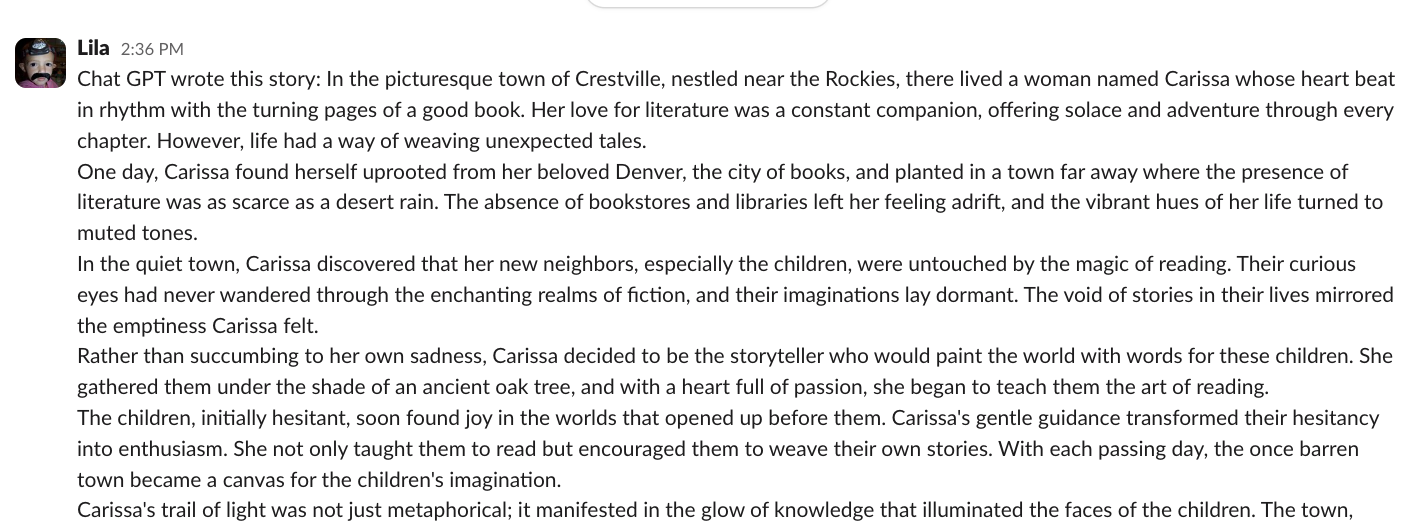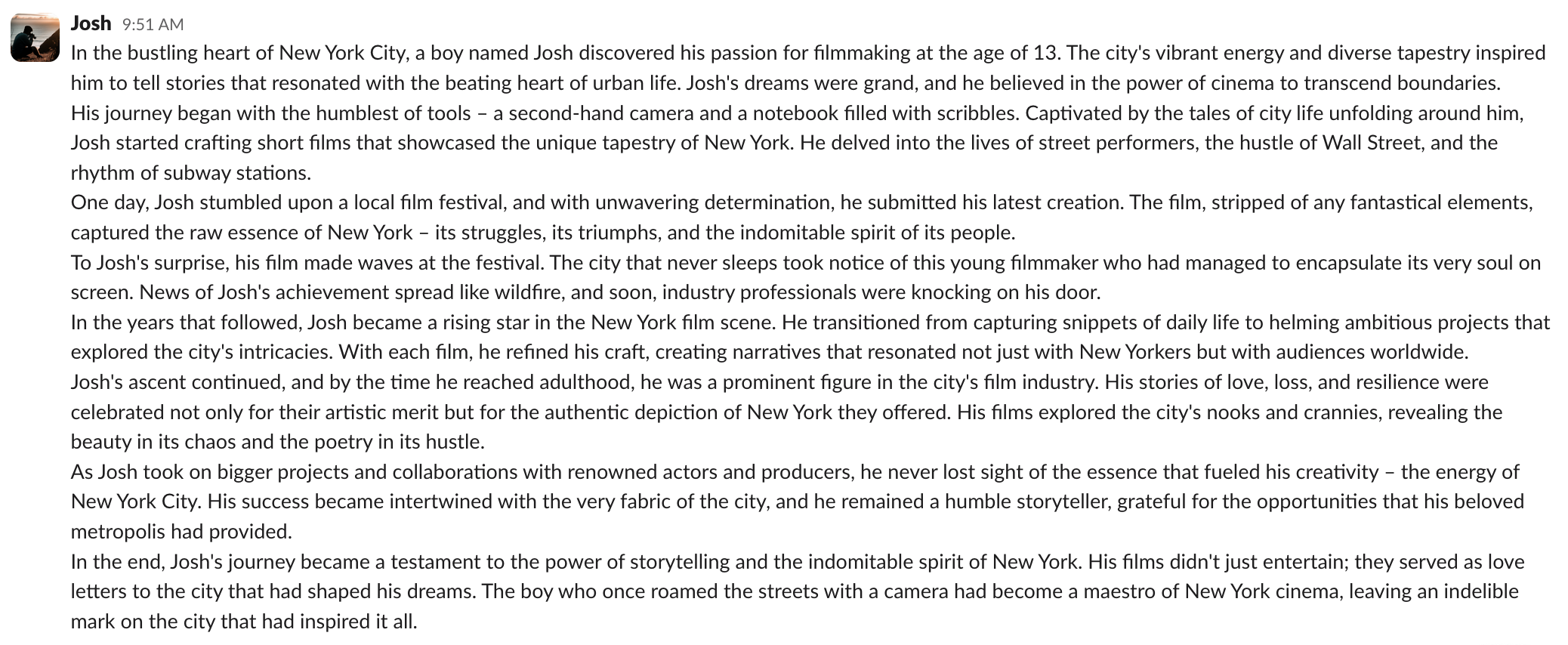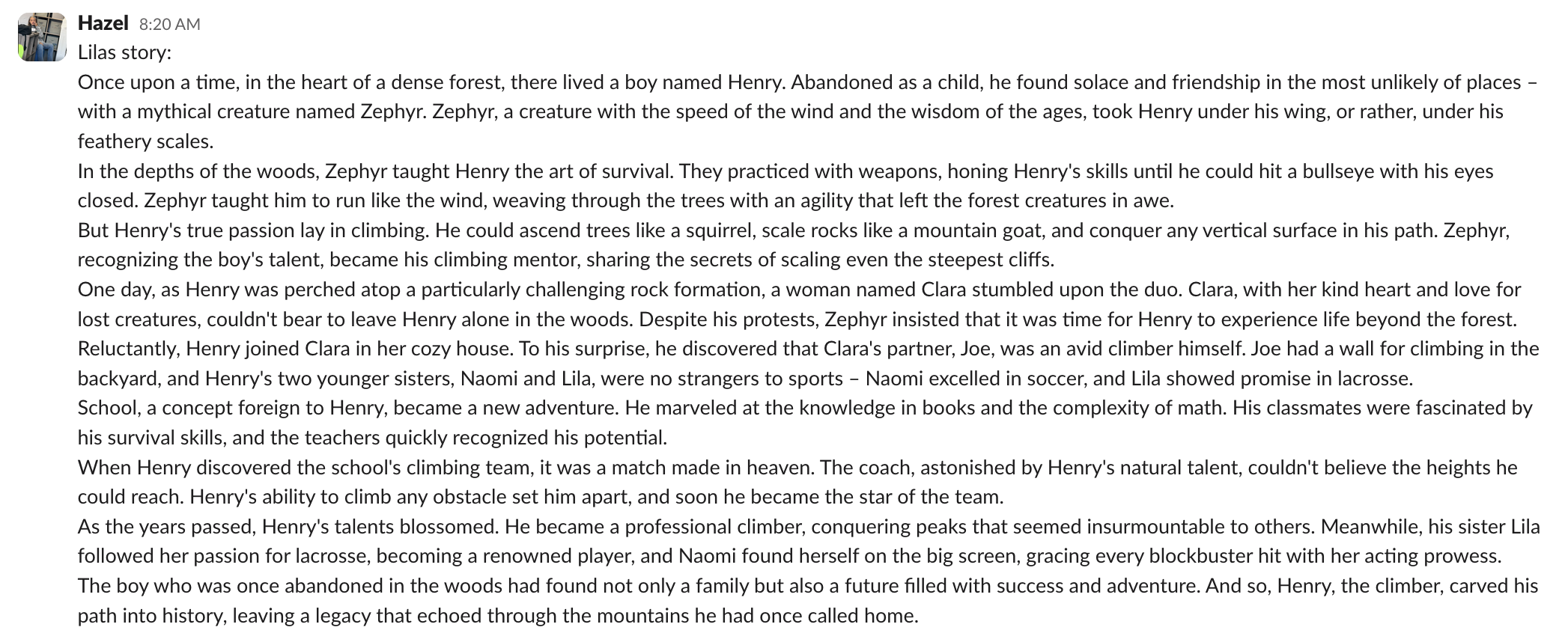AI and Agency at Embark, Part 2
Responsible Uses for AI Chatbots
During Part 1 of our AI and Agency exploration, Embark learners discovered many limitations of AI chatbots. It turns out that new technology doesn’t magically fulfill all our needs. However, we were now in an awkward spot. Having discovered that ChatGPT couldn’t complete their assignments, learners were ready to give up on the tech altogether. I recognized this feeling of learner defeat from when I used to teach financial literacy. Upon learning how credit cards and interest rates really work, many adolescents simply declare that they will NEVER use a credit card. To which I would respond, “Well, friends, it turns out it is pretty much impossible to function as an adult without a credit history.” The real lesson for both credit cards and ChatGPT isn’t to avoid them but learn to use them effectively and responsibly. So, the next step in our exploration of AI was clear - how can we best use AI to support learning?
“I learned that you should give ChatGPT specific and serious commands if you want a good answer.”
And so, Embark learners and I set out on the second leg of our AI journey. The experience of exploring this new tech together is a perfect example of Embark’s mindset of radical trust. Rather than requiring learners to wait until adults thoroughly vet the technology without learner input or penalizing learners for using it alone, we did the work together. I guided their explorations to ensure that they were safe and reasonably productive. Meanwhile, learners provided the curiosity, perspective, and time needed to explore AI in new and unique ways.
Exploring AI’s Uses
Like any tool, AI chatbots’ output is only as good as the input it is provided. So, my first goal was to help learners understand how to provide good initial input. In our first guided exploration of AI, learners asked ChatGPT to write informative and persuasive essays for them. They drew some fantastic conclusions about the uses and limitations of AI chatbots in this particular realm, but we wanted to learn more about what AI’s other capabilities might be. Could it help learners practice skills, learn new ideas, or generate other useful content? We experimented with two starting prompts to find out. We asked ChatGPT to
Write a song celebrating your mom’s 50th birthday,
Explain the similarities between the books Hello, Universe by Erin Entrada Kelly, The Remarkable Journey of Coyote Sunrise by Dan Gemeinhart, Counting by 7s by Holly Goldberg Sloan, and Nowhere Boy by Katherine Marsh.
Learners were initially proud of each of these prompts. They thought they had clearly described the task they wanted ChatGPT to perform and given at least one specific detail to guide its work. They were not pleased with the results. The song was too long and generic, and ChatGPT could only provide “general guidance on how you might find similarities between the books…themes, writing styles, setting, etc.”
At this point, we referenced a great Prompt Framework for Students created by AI for Education, which introduced learners to the Five S Model. This model directs learners to specify the prompts they give AI chatbots to improve their results. The suggested techniques include:
“I cannot begin to explain the power that results from this co-creation of new knowledge. We all approached our exploration from a learners’ mindset, so learners weren’t afraid of getting the answer wrong because there was quite literally no right answer.”
Set the scene
Be specific
Simplify your language
Structure the output
Share feedback
We applied this new knowledge to our original queries. We asked that the song be shortened to two verses, written in the style of Taylor Swift, and provided more personal details about the mom in question. We also told ChatGPT that the books all had themes of friendship and finding joy in the face of challenges and that we wanted to write an Instagram story in the voice of a middle-grade literacy teacher. Set the scene, be specific, and structure the output - check, check, check. We even took the Insta request one step further and gave ChatGPT feedback that it was using too many emoticons in its response, and it quickly altered its results. Share feedback - check. (Side note: The Instagram prompt was a real example of content I posted on my professional account. The learners had LOTS to say about how I could improve my stop motion video abilities.)
The consensus among learners was that the more detail we gave ChatGPT, the better its responses became. Learners still weren’t thrilled with the results, but they were able to see that they were significantly better than the originals. With this baseline in mind, I asked learners to experiment with ChatGPT independently. They were instructed to start with a pretty general prompt and gradually add details using the 5 S Model to see how dialed in they could get ChatGPT’s responses.
Original Response
Our first attempt to prompt ChatGPT to compare four middle grade novels did not yield the results learners hoped for.
Final Response
ChatGPT’s final response after we set the scene, gave it specific information to include, structured the output, and shared feedback.
Check out the full conversation we had with ChatGPT here.
Learners’ Discoveries
Through this exercise, learners discovered many helpful and fun uses for ChatGPT. First and foremost, they reinforced our initial finding that AI chatbot responses are only as good as your input. “I learned that you should give ChatGPT specific and serious commands if you want a good answer, explained 7th-grader Max. Fellow 7th-grade learner Walden learned “the importance of giving specific details. This is important because if you don't give specific details, you won't get a specific answer.” While Hazel, another 7th-grade learner, “learned that AI can do a lot of cool things when given enough information. For example, it can give me book recommendations, and they get more specific the more I tell it about myself.” And 6th-grader Naomi explained, "AI works best when I give it more context. I can use it more successfully when asking questions that have a context, like writing a poem about my mom. She likes all colors and pandas. That's an example of giving context.”
This learning was significant, but the most fun came in the new and unexpected ways learners used AI to benefit themselves. Here are just a few examples:
Holding Conversations: Maura (8th grade) explored Chat GPT’s conversational abilities - holding conversations with it in English, Spanish, Morse code, and even a letter-number cipher where A = 1 and Z = 26. As Embark doesn’t have a foreign language program, Maura was excited about using ChatGPT to practice Spanish. She’s used programs like Duolingo before but liked that ChatGPT could hold real conversations, react to her inputs, and roughly match her conversational level.
Drafting Short Stories: Max discovered that “it can be creative because it is good at making things up. I found out that it is especially good when making fiction stories because it doesn't need real-life facts to make those up.” 8th-grader Lila also experimented with this capability, having ChatGPT write personalized short stories for her friends and me! You can check out three of her stories below.
Building an Essay Outline: Many learners reflected that ChatGPT could be a good first step in building an essay outline. They talked about the paralysis they feel when faced with a blank page and how getting some initial ideas from AI could help them have something to react to. As learners put it, an AI-generated outline “can give you a starting point for further research,” and you can use AI’s ideas as a “guide and then add some of your own details.” (Natalia, 7th grade & Kai, 8th grade)
Help Understanding Difficult Concepts: Josh (8th grade) experimented by asking ChatGPT to explain questions on some assignments or write instructions in more straightforward language. While Walden reflected, “Some ways you can productively and safely use Chat GPT is by asking Chat GPT to give you a better understanding of a concept you are trying to learn. This could come in handy if a teacher is unavailable or the way the teacher explained it to you does not make sense.”
Copy Editing: Dixon (7th grade) found that AI chatbots can help you “if you need to improve your paragraph or essay. You can easily tell the AI to find run-on sentences, grammar, etc. in your essay.”
Through this work, learners paired their understanding of ChatGPT’s limitations with a newfound view of how it could be a helpful tool. Again, we removed some of the AI chatbots' mystery and scandal by permitting them to experiment with it in a safe, trusted environment. As a bonus, learners came up with all kinds of interesting uses for ChatGPT that Embark educators would never have thought of and deeply reflected on how these uses could be beneficial. I pulled all the learner quotes in this article directly from learners’ written reflections. I cannot begin to explain the power that results from this co-creation of new knowledge. We all approached our exploration from a learners’ mindset, so learners weren’t afraid of getting the answer wrong because there was quite literally no right answer. Instead, they gleefully reported every weird (ChatGPT won’t teach you how to pick a lock!), practical (Do you know it provides better grammar support than Grammarly?), and unexpected thing (It refused to respond to more than 40 inputs in an hour!) that they discovered, practically the definition of a curious learner using a growth mindset!
Like what you learned here? Stay tuned for the next AI and Agency at Embark series installment, Drafting a Terms of Use Protocol for AI at School.






